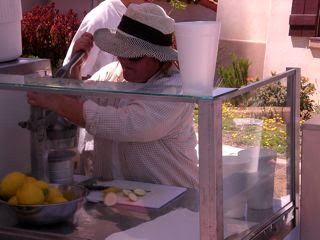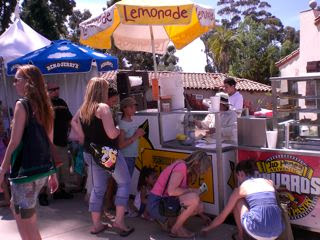 On Sunday, April 19, San Diego celebrated Earth day at Balboa Park. It was the largest fee annual environmental fair in the world and had around 70,000 visitors.
On Sunday, April 19, San Diego celebrated Earth day at Balboa Park. It was the largest fee annual environmental fair in the world and had around 70,000 visitors.
With 400 volunteers, The Earth Fair featured more than 400 exhibitors, special theme areas, a Food Pavilion, a special Kids’ Activity Area, three entertainment venues, the Children's Earth Parade, the eARTh Gallery art show, and the Cleaner Car Concourse.
The most interesting thing about San Diego Earth Fair was that it was working toward becoming a Zero Waste Event.
Earth Works in collaboration with EDCO and Urban Corp of San Diego, was behind this effort.
Recycling bins had been available since the beginning of Earth Day and this time bins to collect organic materials for composting were been added. The organics bins(green) along with recycle(blue) and trash (Black)bins comprised the "Zero waste station".
We(Tarun my hubby & me) along with hundreds of others volunteered at the zero waste station to make sure that the attendees use the appropriate bin.
 We were there to guide, and used this opportunity to teach attendees how zero waste can eliminate the need for landfills and concepts such as “waste”.
We were there to guide, and used this opportunity to teach attendees how zero waste can eliminate the need for landfills and concepts such as “waste”.
We also educated attendees about the need for manufacturer redesign and responsibility, greenhouse gas emission reductions by recycling, and monetary value of resource management versus landfill reliance.
It was a extremely fulfilling and educating task. It was an extremely hot day but we had the time of our life!
And our efforts paid off.
About 2.33 tons of waste was sent for recycling, 1.28 tons for composting and .9 tons to the landfill. We achieved a total of 80% diversion rate!!
And this was in spite of some crazy lemonade people selling their stuff in Styrofoam containers.
 This is how our trash(black) bin looked like. Mostly filled with Styrofoam. :( It was an exceptionally hot day and people drank lots of Lemonade.
This is how our trash(black) bin looked like. Mostly filled with Styrofoam. :( It was an exceptionally hot day and people drank lots of Lemonade.
 Imagine celebrating earth day with Styrofoam! Some businesses just don't have any sense of right or wrong.
Imagine celebrating earth day with Styrofoam! Some businesses just don't have any sense of right or wrong.







